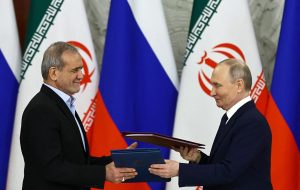Russia-Iran strategic partnership’s effects on the resistance front
BEIRUT — The comprehensive strategic partnership agreement between Tehran and Moscow constitutes a remarkable geopolitical step, as it coincides with the resounding defeat of the US-led Israeli aggression on people in certain nations in West Asia. Following the fall of the Bashar al-Assad government, Russia immediately confirmed that the Syrian developments “will not threaten its


BEIRUT — The comprehensive strategic partnership agreement between Tehran and Moscow constitutes a remarkable geopolitical step, as it coincides with the resounding defeat of the US-led Israeli aggression on people in certain nations in West Asia.
Following the fall of the Bashar al-Assad government, Russia immediately confirmed that the Syrian developments “will not threaten its relations with Iran.”
During an interview with Sputnik, Sergey Lavrov, Russia’s foreign minister, declared that the agreement with Iran is “comprehensive and long-term,” noting that it attaches importance to strengthening security cooperation and combating terrorism, in addition to confronting “many common challenges and threats.”
The increased level of coordination between Tehran and Moscow seriously worries political and security decision-makers in Tel Aviv, which is witnessing a critical transitional phase.
An analysis by the Israeli Institute for National Security Studies has warned of Iran’s role as an important arms supplier to Russia, which “causes deep concern in Israel and Western capitals.”
It pointed out that the occupation entity’s increasing involvement in wars of attrition in West Asia “is in line with Russia’s interest in occupying American and European resources outside the Ukrainian arena.”
2007 marked a turning point in Russian politics following Vladimir Putin’s famous speech at the Munich Security Conference in which he warned against “unipolarity.”
Since the establishment of BRICS in 2007, Moscow has sought to introduce an alternative currency for international and interstate trade to replace the dollar as one of the most important tools of Washington’s hegemony over the global economy that also sponsors the Zionist colonial schemes.
Despite its multiple political and economic contradictions, BRICS seriously worries Washington, especially after the active role played by Moscow — militarily, politically and diplomatically — during the so-called Arab Spring.
The recent Russian-Iranian rapprochement has coincided with the Israeli enemy’s nibbling away at large areas of the West Bank and the Golan Heights, and the implementation of the “David’s Corridor” plan.
The David’s Corridor is an expansionist plan aimed at dividing Syria into a Druze state in the south and a Kurdish state in the north linked by the Tanf Corridor. This insists on keeping the US occupation forces in northern Syria to plunder its oil and gas reserves.
The declared effort to establish a Kurdish state overlooking the Mediterranean Sea seeks to expand towards the Caspian Sea (rich in natural resources) and later control Armenia and Iranian Azerbaijan.
That is why Ilham Aliyev, the Azerbaijani president, has manipulated the plane crash incident downed by Russia while confronting Ukrainian drones as a justification to exacerbate relations with Moscow, and thus obstruct trade between the port of St. Petersburg and the ports of Bushehr and Bandar Abbas, which passes through Azerbaijan.
When discussing foreign policy issues, according to the Washington Institute for Near East Policy’s analysis , the mainstream media often refers to two axes: the “Eurasian axis” consisting of China, Russia, Iran, and North Korea, and the “Axis of Resistance” that “Iran leads in the Middle East.”
The report adds that despite the differences between the members of each axis and their motivations, both are composed of “strong opponents of the US” who share views that oppose the West and the U.S.-led world order, noting that Iran is the “vital node” at the “intersection between the two axes.”
The Washington Institute for Near East Policy notes that Iran makes it difficult for Washington’s opponents to reach West Asia. Therefore, it should be the focus of future Western efforts by: preventing it from acquiring any nuclear weapons; undermining its missile industry and military production capacity; disrupting its supply lines; continuing to undermine the Axis of Resistance; and reducing the resources available to Tehran to support both axes by imposing embargoes and sanctions on its oil exports.
The report points to the need to rely on the Persian Gulf states, which can finance “a regional stockpile of ammunition for US Central Command partners that can serve as a reserve” to confront any potential developments in other regions, along with disrupting the supply chains of the two axes, through tightening export restrictions; sanctions; cyber efforts; and – when necessary – carrying out sabotage and covert operations.
In a world of loose poles, Trump, who – along with billionaire Elon Musk – has begun to turn Western governments against others, will not spare our people if they neglect preparation, readiness, resistance, and alliance with independent forces fighting the US imperialism.
This has further coincided with Trump’s provocative intentions to annex Canada, the Panama Canal and Greenland in a bid to tighten control over the European continent, i.e. Russia’s borders.
The Russian-Iranian rapprochement also coincides with Israeli concerns about the Turkish-Iranian rapprochement, which suggests a quasi-Turkish withdrawal from the regional confrontation.
